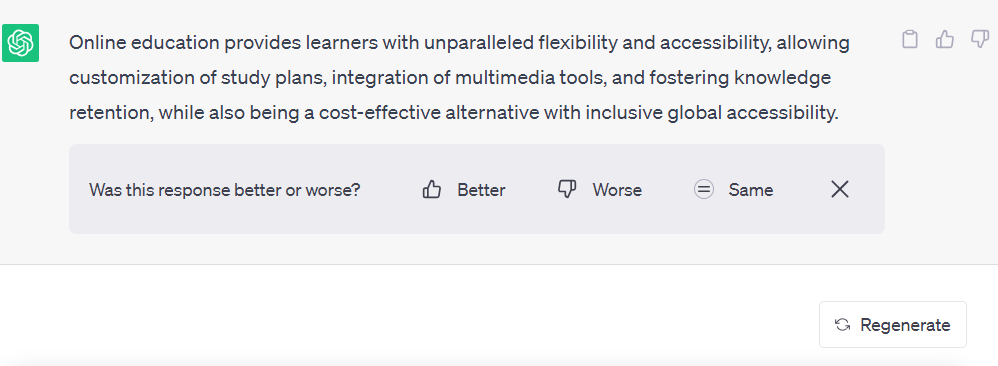An essential component of every essay or dissertation is a well-crafted conclusion using ChatGPT, which plays a crucial role. It effectively condenses your primary arguments and accentuates the ramifications of your research. Your conclusion must faithfully represent your own research and discoveries. Nevertheless, ChatGPT can be employed throughout the writing process.
- Create a structured framework for your conclusion
- Summarize text
- Paraphrase text
- Offer constructive input
| Universities and other institutions are currently in the process of formulating their positions regarding the appropriate usage of ChatGPT and similar tools in crafting a conclusion using ChatGPT. It is essential to prioritize adhering to your institution’s guidelines over any advice found online. |
Create a framework for the conclusion using ChatGPT
The conclusion, serving as one of the final segments in your written work, offers a valuable opportunity to provide an extensive and all-encompassing overview of your research findings, presenting them in a well-structured and logically sequenced manner using ChatGPT.
To enhance the crafting of a compelling conclusion using ChatGPT, an AI tool that helps develop potential outlines. It assists in creating a succinct summary with crucial elements like research questions, central arguments, key findings, and, for longer papers, chapter or section titles for a clearer roadmap.
By using the ChatGPT output as inspiration, you can stimulate creativity, streamline thoughts, and skillfully rearrange and fine-tune content to align with your essay while reflecting on your research and arguments. This integration of technology and human effort results in a compelling conclusion using ChatGPT that leaves a lasting impression on your audience.
| Construct a framework for the conclusion of your essay. The essay is 2000 words on the role of the effectiveness of online education compared to traditional classrooms. | |
| 1. Recap of Main Points: • Summarize the key findings and arguments presented in the essay regarding the effectiveness of online education and traditional classrooms. 2. Address the Research Question: • Revisit the initial research question and provide a clear answer based on the evidence and analysis presented throughout the essay. 3. Advantages and Disadvantages of Online Education: • Discuss the advantages of online education, such as flexibility and accessibility, and the potential disadvantages, such as limited face-to-face interaction and technological challenges. 4. Benefits of Traditional Classrooms: • Acknowledge the benefits of traditional classrooms, including in-person interactions, immediate feedback, and a structured learning environment. 5. Overall Effectiveness of Online Education: • Evaluate the overall effectiveness of online education, considering its potential to cater to diverse learners and the role of advanced technologies in enhancing the learning experience. 6. Recommendations for Improving Online Education: • Suggest strategies to improve the effectiveness of online education, such as integrating interactive elements, fostering a sense of community, and providing adequate support for students. 7. Future Implications and Research: • Explore the potential future developments in online education and highlight areas for further research to continuously enhance its effectiveness. 8. Concluding Remarks: • Provide a concise and impactful closing statement that emphasizes the significance of the topic and the need for continued evaluation of online education and traditional classrooms. 9. Final Thought: • End with a thought-provoking remark or call to action that encourages readers to reflect on the role of education in shaping the future and the evolving landscape of learning environments. |
| The framework can be adjusted based on the specific content and structure of the essay, but it should ensure a coherent and comprehensive conclusion that effectively addresses the research question and summarizes the main points discussed in the essay. |

Summarizing your arguments
In your conclusion using ChatGPT, you’ll recapitulate your main arguments and findings.
AI tools like ChatGPT can help you condense your writing to its key points. By copying and pasting sections of your essay into ChatGPT and prompting it to summarize the text, you can efficiently achieve this.
Yet, it is crucial to be aware that ChatGPT outputs in the conclusion may not always be reliable and could include inaccuracies. Therefore, carefully review the output to ensure it aligns with your requirements and accurately represents the original text.
| Summarize the paragraph in one line: “Online education offers distinct advantages, including unparalleled flexibility and accessibility for learners. The self-paced nature allows students to customize their study plans, balancing work, family, and education effectively. Online platforms integrate multimedia tools and interactive resources, catering to diverse learning styles and fostering knowledge retention. It is a cost-effective alternative, minimizing expenses and providing access to affordable learning materials through open educational resources. By harnessing technology, online education breaks down barriers, creating an inclusive and accessible learning environment worldwide.” | |
| Online education provides unmatched flexibility and accessibility, with self-paced learning, interactive resources, and cost-effectiveness, creating an inclusive global learning environment. |
A useful aspect of ChatGPT is that you can always “regenerate” the received answer. This means that if you don’t like an answer, you can always get a new one.


| Using ChatGPT outputs as your own work might be seen as plagiarism or academic dishonesty, which AI detectors can detect. Instead, use ChatGPT outputs as inspiration to express your arguments and findings in your original words. |
Paraphrasing text
Crafting an original conclusion using ChatGPT can effectively summarize your essay, but it presents challenges in achieving coherence and impactful delivery, necessitating a critical review of ChatGPT’s output for alignment with your essay’s themes. Use ChatGPT as a complementary tool, incorporating your critical thinking and writing skills to ensure the final conclusion reflects your unique insights and contributes to a well-crafted and impactful ending for your work.
| Paraphrase the following sentence: “Technology has transformed education, providing enhanced engagement and access to diverse learning materials, but challenges like the digital divide call for a robust infrastructure to ensure equitable access for all.” | |
| Education has been revolutionized by technology, offering improved engagement and access to a wide range of learning materials. Nevertheless, the digital divide necessitates a strong infrastructure to ensure equal access for everyone. |
| Understanding the safe usage of ChatGPT is crucial. The tool may retain and use its previous outputs for training, so avoid inputting sensitive or personal data. |

Generating feedback
When you’ve finished writing your conclusion, you can prompt the AI to review your work and suggest corrections. You can be as specific as you like, mentioning aspects such as tone, clarity, and coherence of structure.
After completing your conclusion, you have the option to utilize ChatGPT to receive feedback and recommendations for improvements. You can be precise in your requests, focusing on aspects like tone, clarity, and structural coherence.
While ChatGPT can serve as a grammar and punctuation checker, it may occasionally overlook errors since it’s not specifically tailored for this purpose. For more accurate results, consider using a specialized grammar checker and proofreading on our platform. Alternatively, for comprehensive feedback, explore our editing service.
| Offer feedback on the preceding text concerning its tone, clarity, and structural coherence. | |
| The preceding text is well-written, concise, and coherent. The tone is objective and informative, discussing the positive impact of technology on education while acknowledging the challenges related to the digital divide. The clarity is excellent; it effectively conveys the main points in a straightforward manner. The text highlights two distinct aspects: the transformation of education through technology and the need for a robust infrastructure to address the digital divide. In terms of structural coherence, the text flows logically, first presenting the benefits of technology in education and then addressing the challenges associated with the digital divide. The transition between these two points is smooth and well-executed. Overall, the text is clear, well-structured, and effectively communicates its message. It succinctly conveys the dual nature of technology’s impact on education, with a balanced approach to discussing both the advantages and challenges. Adding specific examples or data could further enhance its impact, but as it stands, the text is informative and coherent. |
Conclusion
| The tools can provide rapid initial feedback on your writing, but crafting a conclusion using ChatGPT, should not replace the guidance of an experienced academic advisor. Whenever feasible, consult your professor or supervisor instead of relying solely on ChatGPT. |
